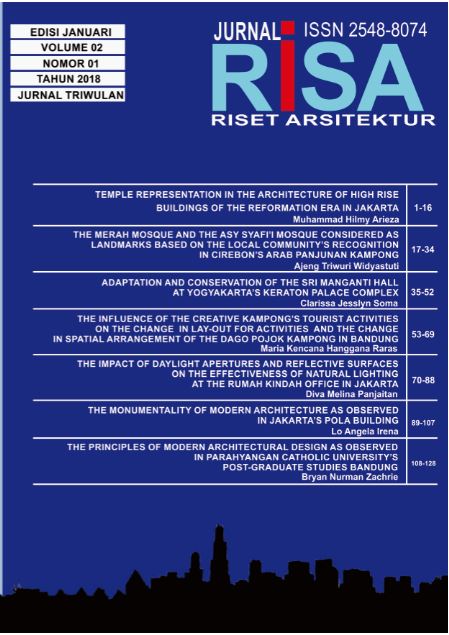THE MERAH MOSQUE AND THE ASY SYAFI’I MOSQUE CONSIDERED AS LANDMARKS BASED ON THE LOCAL COMMUNITY’S RECOGNITION IN CIREBON’S ARAB PANJUNAN KAMPONG
DOI:
https://doi.org/10.26593/risa.v2i01.2930.17-34Abstrak
Abstract - The Arab Panjunan kampong serving as the research object happens to be one of the heritage areas of Cirebon Town. This urban kampong has certain ethnic characteristics typical of Arab quarters that make it unique, thus contributing to the rich cultural history of Cirebon. As a heritage area, it is important for this ethnic Arab neighbourhood of Panjunan to draw up an inventory of the specific architectural elements that are still traceable, such as the urban lay-out and its contents as well as the landmarks of this area observed from a physical-spatial angle. The aim of this research project is to find out about this kampong’s various architectural elements that are recognized as such by the locals. This will be the contributing factor in the process of determining which environmental elements can be classified as typical landmarks. The first step taken in the research conducted is field observation in order to establish the elements that have survived in the kampong, including the architectural, social, and cultural ones. The observation related to architectural elements has been identified in accordance with the theory concerning Elements of Urban Design as proposed by Hamid Shirvani in his book The Urban Design Process. The next step is conducting research using the Cognitive Method as applied to the kampong dwellers in Panjunan by way of sketched maps and guided interviews. The respondents, classified based on ethnic heritage (descent) and gender, were requested to describe the environmental elements in this ethnic Arab kampong as far as they could recognize or identify them. Those who experienced difficulties in describing the sketches were assisted by the researcher based on the stories that had been supplied. Based on the acquired data containing these environmental elements, the aspect of memories contained therein was studied by way of interviews linked to the Continuity Theory by Breakwell. Subsequently, an analysis was made of the basis underlying the recognition of these elements based on the Landmark Theory by Kevin Lynch, and classified based on the criteria drawn up by Eko Budihardjo. Through the analysis, it was discovered that Panjunan’s Merah Mosque and its Asy Syafi’i Mosque indeed qualify as as architectural elements that show continuity of memory, gaining validity as iconic elements or landmarks on the regional scale of Cirebon’s ethnic Arab kampong of Panjunan.
Keywords : mosque, landmark, recognition, local community, Arab Panjunan kampong









